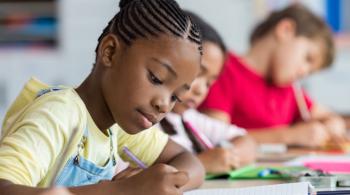By Carrie Schiel, M.S., CCC-SLP
November 24, 2015
Carrie Schiel is a former Center for Innovation and Learning in Special Education (CILSE) fellow and a school-based speech-language pathologist with over ten years’ professional experience. Currently, she specializes in the evaluation of pre-school aged children as part of the Developmental Evaluation Services for Children (DESC) Team for Montgomery County Public Schools.
For ten years, I have worked as a speech-language pathologist in a variety of public schools, and I am often asked, “Besides helping students learn to say their sounds correctly, what else do you do?” Regardless of whether I’m asked by a parent, teacher, or other professional, I never mind answering this question! In fact, since I’ve been asked this question so frequently, I’ve developed one heck of an “elevator speech” to address it.
One of the main areas I highlight in my answer involves the role that speech-language pathologists play (in conjunction with classroom teachers and other specialists) in establishing and strengthening students’ literacy skills. Many people assume these skills are solely targeted in the classroom, given the connection between spoken language and literacy, and are surprised that language specialists would be involved in this process.
For students to succeed in school and life, becoming literate is vital. One of the first steps in becoming literate involves fostering early speech and language development. From the day they are born, the input and responses received from their caregivers helps them to build their understanding and use of language. Simple games and routines that practice sound manipulation and letter recognition, as well as interaction with books and exposure to print in the community, creates the foundational skills children need to be prepared to read and write. Eventually, “children combine what they know about speaking and listening with what they know about print and become ready to learn to read and write” (Roth, Paul, & Pierotti, 2006).
Listed below are suggestions, in four important language skill areas, for education professionals and parents to assist students in becoming successful readers:
- Phonological awareness involves hearing and understanding the sounds that make up words. To strengthen skills in this area, have students work on activities that involve listening to, deciphering, and creating their own rhymes. You may also group students and encourage them to be “sound detectives,” isolating, categorizing, and blending the sounds and syllables of that week’s spelling words.
- A strong and varied knowledge of vocabulary provides students with an excellent base on which to further develop their literacy skills. Reading aloud to students is a great way to expose them to a wide variety of words, both incidentally and explicitly. When explicitly teaching the meaning of novel vocabulary words, be sure to assist students with: pronouncing the new word; discussing the context in which the word occurred; generating synonyms for the novel word; and guessing its meaning. Creating a word wall with visual supports and referring to it frequently, either in the classroom or at home, is another great tool for increasing students’ exposure to and interaction with novel words.
- Developing an awareness and understanding of the impact that word endings, sentence structure rules, and different parts of speech have on meaning is a very important connection to help students establish when learning to read. To highlight these sometimes subtle differences, pair pictures with sentences to help students visualize how different word endings (e.g., /s/, /ing/, /ed/) change meaning. Or, for slightly older students, try activities that require manipulation of words and sentences. For example, write a variety of nouns, verbs, and direct objects on strips of paper. Also include strips containing word endings that function to change the tense of the words. Then assist students with categorizing words and creating grammatically correct and logical sentences.
- Development of solid comprehension and critical thinking skills is the final piece to helping students put together the literacy puzzle. When your students are interacting with books, capitalize on opportunities to engage in and model self-talk about your thoughts and feelings when looking at the different pages. Ask questions that include both the pictured scenarios and abstract concepts such as predictions (e.g., “What do you think will happen next?”). Follow up with having students justify their answers by saying, “Tell me what makes you think that.”
The connection between spoken language and literacy is clear and should be targeted well beyond the walls of a classroom. Whether through a structured book activity or a simple walk through the community, opportunities abound to foster students’ literacy skills through the use of language activities.
References:
Roth, F. P., Paul, D. R., & Pierotti, A.-M. (2006). Let's Talk: For People with Special Communication Needs. Retrieved September 17, 2015, from American Speech-Language-Hearing Association : http://www.asha.org/public/speech/emergent-literacy/















